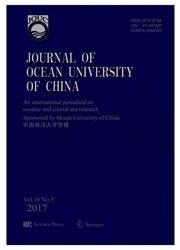

 中文摘要:
中文摘要:
This study examined the effect of salinity on the expression of Na+/K+-ATPase(NKA) α-subunit and vacuolar-type H+-ATPase(V-ATPase) β-subunit gene in the gill of Litopenaeus vannamei. Semi-quantitative reverse transcription-polymerase chain reaction(RT-PCR) assay showed that the expression of NKA α-subunit and V-ATPase β-subunit gene was significantly influenced by salinity. It was found that the NKA activity significantly varied with salinity in time and dose dependent manner; whereas the V-ATPase activity did not. The abundance of NKA α-subunit gene transcript increased rapidly when the salinity decreased from 26 b to 21, and slowly when the salinity decreased from 26 to 31 within the first 24 h. When the salinity decreased from 26 to 21, the transcription of NKA α-subunit gene in gill epithelium was higher at 12 h than that at 0 h, which was consistent with the result of immunoblotting assay of NKA α-subunit. In addition, salinity had a significant time- and dose-dependent effect on the concentration of biogenic amines in both hemolymph and gill. As compared to other parameters, the concentration of dopamine(DA) and 5-hydroxytryptamine(5-HT) varied in different patterns when the salinity decreased from 26 to 21 or increased from 26 to 31, suggesting that DA and 5-HT played different regulatory roles in osmotic adaption and modulation of shrimp when salinity varies.
 英文摘要:
英文摘要:
This study examined the effect of salinity on the expression of Na^+/K^+-ATPase (NKA) α-subunit and vacuolar-type H+-ATPase (V-ATPase) β-subunit gene in the gill of Litopenaeus vannamei. Semi-quantitative reverse transcription-polymerase chain reaction (RT-PCR) assay showed that the expression of NKAα-subunit and V-ATPaseβ-subunit gene was significantly influ-enced by salinity. It was found that the NKA activity significantly varied with salinity in time and dose dependent manner;whereas the V-ATPase activity did not. The abundance of NKAα-subunit gene transcript increased rapidly when the salinity decreased from 26b to 21, and slowly when the salinity decreased from 26 to 31 within the first 24 h. When the salinity decreased from 26 to 21, the transcription of NKAα-subunit gene in gill epithelium was higher at 12 h than that at 0 h, which was consistent with the result of immunoblotting assay of NKAα-subunit. In addition, salinity had a significant time-and dose-dependent effect on the concentration of biogenic amines in both hemolymph and gill. As compared to other parameters, the concentration of dopamine (DA) and 5-hydroxytryptamine (5-HT) varied in different patterns when the salinity decreased from 26 to 21 or increased from 26 to 31, sug-gesting that DA and 5-HT played different regulatory roles in osmotic adaption and modulation of shrimp when salinity varies.
 同期刊论文项目
同期刊论文项目
 同项目期刊论文
同项目期刊论文
 期刊信息
期刊信息
